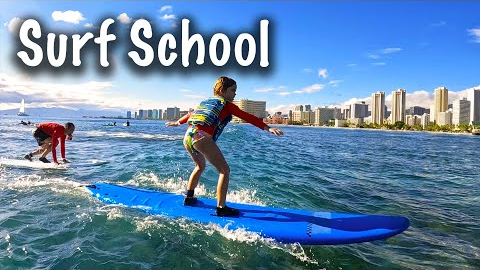🏄🏼♀️ First Time Surfing Waikiki || Kids Surfing Lessons for my Daughter || Living in Hawaii
4,218 View
Share this Video
- Publish Date:
- June 23, 2025
- Category:
- Surfing
- Video License
- Standard License
- Imported From:
- Youtube
Tags

Hawaii little surfer girl, first time surfing at Waikiki, Honolulu
After watching her Dad have his first surfing lesson, Alex, my 7 year old little girl wanted to try it herself. Alex has been boogie boarding for the last few month and while she has been ok at it, she has really wanted to try surfing. John had amazing success with the Ohana Surfing Project for his first lesson two weeks ago. We are not affiliated with them, but they had great reviews and did such a great job teaching John to surf that we did it again for Alex. We did a few google searches for kid surfing lessons, and there were other companies out there, but we liked that Alex was going to have her own board. She could wear a life jacket, and all they asked is if she was going to be resilient and not discouraged by falling off her board. Alex is a pro at falling and getting tossed by the ocean waves so we went for it. #surfinggirl
https://www.ohanasurfproject.com @ohanasurfproject5644
John and I are not affiliated or soonsored by Ohana Suef Project.
🪖 If you new to our channel, John re-enlisted in the military after being out for ten years. Kind of crazy. But John was a Marine and he loved the Marines. Afghanistan Veteran. The only reason he got out was for me. Back before online jobs or school, he gave up the Marines and allowed me to start my career. I had an amazing career spending years growing and working with Target as a Store Director. But with Covid came many changes. One of those was to stay home and homeschool Alexandra. And so it opened the door for John to do whatever he wanted to do. He re-enlisted, but this time we both agreed the Army. But after being out so long, John had to go through Basic training again or OSUT. Six months of that followed by waiting for command sponsorship for our first OCONUS move and the family has been apart for 10 months. Crazy considering this wasn't a deployment. But we made it! #MilitaryFamilyVlog We are now stationed at Schofield Barracks in Hawaii for the next 2 to 3 years and feel truly blessed to be here!
American Dream T-Shirts
https://www.bonfire.com/store/pursuit-of-the-american-dream/
🇺🇸 Camera Gear
GoPro Hero 10: https://amzn.to/3xvKd3d
GoPro Hero 9: https://amzn.to/3JKOKBq
GoPro Max Lens Mod: https://amzn.to/3JKc5Dp
GoPro Max: https://amzn.to/3OgZtao
Rode Microphone Wireless Go 2: https://amzn.to/3EhkpJC
Rode Microphone: https://amzn.to/3uMsKlD
🎵 Epidemic Sound
https://www.epidemicsound.com/
🎬 Start Here Videos:
https://youtu.be/6ymZnkyk2_g
Contact Us At:
[email protected]
Surfing lesson for kids, #OhanaSurfingProject, little girl, learning to surf, hawaii, oahu, Waikiki Beach, queens beach, best surfing lessons for kids, little girl learns to surf, kid surfing lesson, beginner surfer
-----------------------------------
Barrier Builders: Tidal Sediment and Erosion Sculpting Coastal Sandbar Formations and Shoals
Understanding Sandbar Formations
Sandbar formations are fascinating natural structures that play a crucial role in shaping our coastal landscapes. These underwater ridges, composed primarily of sediment, are formed by the continuous action of tides and currents. As tidal waters move in and out, they transport and deposit sediment, gradually building up these barriers and shoals that define the coastal regions.
The Role of Tidal Forces
Tidal forces are the primary drivers behind the formation of sandbars. The ebb and flow of tides create dynamic water movements that redistribute sediment along the coastline. During high tide, water levels rise, allowing sediment to spread out, while low tide exposes these sediments, leading to their accumulation in specific areas. This cyclic process is essential in shaping the barriers and shoals that protect inland areas from the direct impact of ocean waves.
Sediment Distribution and Coastal Protection
Sediment plays a pivotal role in the development of sandbar formations. The size, type, and availability of sediment materials determine the stability and growth of these structures. Fine sands tend to form extensive, gentle sandbars, while coarser materials can lead to the creation of more resilient and pronounced barriers. These sandbars act as natural buffers, absorbing wave energy and reducing coastal erosion, thereby safeguarding coastal ecosystems and human settlements.
Erosion and its Impact on Sandbar Stability
Erosion is a natural process that influences the longevity and shape of sandbar formations. Strong wave action and storm events can erode these barriers, altering their structure and position. However, erosion also contributes to the continuous reshaping and dynamic nature of coastal environments. Understanding the balance between sediment deposition and erosion is key to managing and conserving these valuable coastal features.
Barriers and Shoals: Distinguishing Features
While often used interchangeably, barriers and shoals have distinct characteristics. Barriers are elongated landforms that run parallel to the coastline, providing significant protection from oceanic forces. Shoals, on the other hand, are elevated areas of shallow water that can extend offshore, posing navigation challenges but also contributing to coastal protection. Both barriers and shoals are integral components of the complex interplay between tidal movements, sediment supply, and coastal dynamics.
The Future of Sandbar Formations
As coastal areas face increasing pressures from human activities and climate change, understanding the formation and maintenance of sandbars becomes more critical. Sustainable coastal management practices are essential to preserve these natural barriers, ensuring they continue to provide protection and maintain the ecological balance. Future research and innovative conservation strategies will play a vital role in safeguarding sandbar formations for generations to come.













